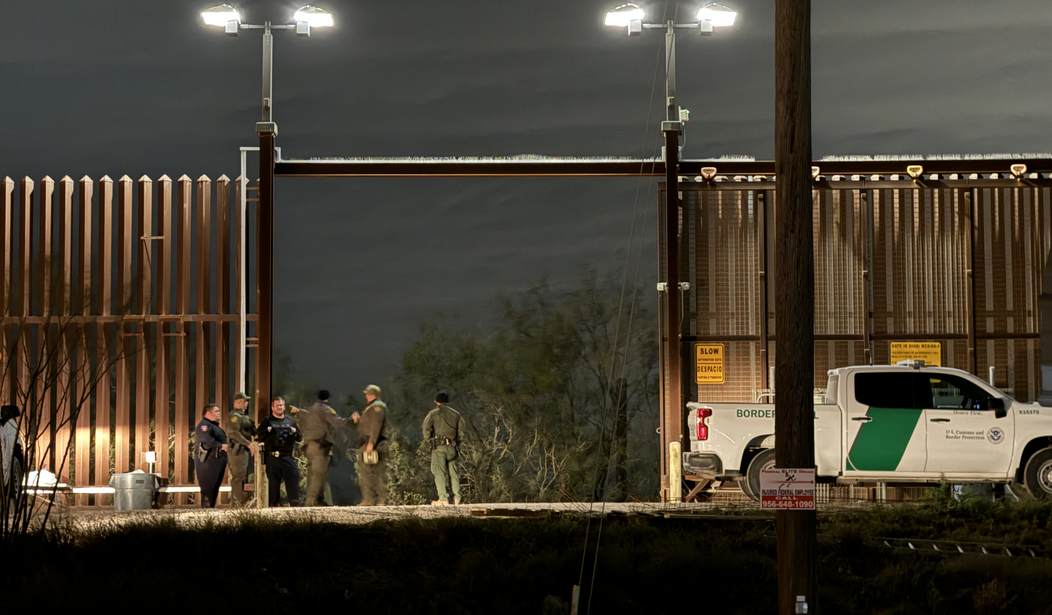HIDALGO, TEXAS — It's just after 9:00 p.m. local time on Friday night when our vehicle pulls into a deserted parking lot near a Whataburger and Jack in the Box just a few blocks short of the international bridge leading to Reynosa, Mexico. I'm riding shotgun with Chris Cabrera, vice president of the National Border Patrol Council as he explains how things have changed in Hidalgo and adjacent McAllen, Texas, in the Rio Grande Valley as the border crisis has worsened.
"We've been seeing more smuggling cases," Cabrera tells me. "A lot more violence going on." Just a few hundred yards from us, beyond a portion of border fencing and a gate atop a 15-foot embankment and the Rio Grande, lies Mexico. Things over in Reynosa have gotten so bad that those seeking to illegally enter the U.S. are often choosing to take longer routes to unlawfully cross in Arizona or elsewhere, according to Cabrera. "Big ol' mess in there right now," he summarizes of the cartels running — and profiting handsomely — off the open border policies of the Biden administration. It's the worst of the worst: Sinaloa, Gulf, Los Zetas. "You can't say the Mexican government is doing its part," Cabrera emphasizes, though it's not like things are being handled as they should on the U.S. side of the border either.
Cabrera explains that the U.S. attorney has decided not to prosecute minors, leading the cartels to recruit minors to do their dirty work. Other authorities are told not to chase those working for the cartels and, even when they are chased or caught, they're just let go anyway. Cabrera points out that a 16-year-old working for the cartels on the American side recently lost control of his vehicle and crashed into a parked 18-wheeler while smuggling two illegal immigrants. "He died on impact and the two passengers are in the intensive care unit," explained Cabrera. "It's a shame, a 16-year-old kid, his life snuffed out for smuggling two guys for what, $100-$200?"
"They hop over the wall a lot right here," Cabrera says as we get out of his SUV to take a closer look at the border wall and gate as buses waiting to transport illegal immigrants to nearby processing centers rumble past. He takes the opportunity to explain one of the ploys used by illegal immigrants.
Recommended
"At any given time, you'll have 40-50 people give themselves up, and while our agents are doing the paperwork on them to get them on those buses, you'll have three different groups within half a mile of here throw ladders up on the wall," Cabrera explains. "Ten or fifteen people at a time will come across at the exact same time knowing that we can't handle all the people that we're writing up and the people that are breaching the wall at the same time. It's a pretty coordinated effort."
While we're standing there, border agents toss a few of the homemade ladders that illegal immigrants have used to the side of a road that runs along the border wall. These are made out of thin rebar. A few steps away, wooden ladders used by other illegal immigrants are piled next to a dumpster. The "newer" rebar ones are "not very sturdy," says Cabrera. "We have a lot of accidents with those — people get halfway up and they just collapse under their own weight."
This spot along the border in McAllen is "one area where people turn themselves in and you have runners in the same area — usually it's one or the other," Cabrera emphasizes. "And then you'll see a lot of drugs come through here and at times you'll have money or guns going south through here, you'll have people trying to smuggle it into Mexico through here," he adds.
Of the illegal immigrants who apprehended or turn themselves in, Cabrera says he's seeing "a dozen" from China in a single day in addition to plenty of Russians and Romanians. He's also seeing illegal immigrants from Iraq, Iran, Syria, Pakistan, and Uzbekistan a few times a month. While many illegal immigrants are still coming up from countries such as Venezuela, he says China remains the most frequent country of origin outside of Central America.
"It's a different group that's coming across, a different type," explains Cabrera. "Not everybody's coming to work, they're coming for asylum — the illusion of asylum — probably 85-90 percent don't qualify," he says. "But for some reason, this administration decided that asylum is whatever they want it to be so people are coming over with all different claims and they're allowed to stay."
"There's a drone up," Cabrera relays as we walk closer to the border wall — the first of several he's alerted to during our nighttime visit along the border wall. The unmanned aircraft are used by the cartels to watch and track where U.S. agents are active on a given night. "They're watching us, but we're watching them," he quips.
A few minutes after 10:00 p.m., he finds out a censor — more specifically a camera — spotted illegal immigrants on the U.S. side of the Rio Grande making their way toward the gate in the wall. While it's unclear how many are with the group, it looks to be multiple individuals, likely a family unit. Meanwhile, other cameras catch literal coyotes slinking through the brush on the barely moonlit night as temperatures dipped into the 40s.
It turns out to be a group of 22 illegal immigrants: one single adult male, four unaccompanied children, and the rest are family units. The youngest is a 16-month-old boy in onesie pajamas. They're from Venezuela, Nicaragua, and Ecuador — and they all claim asylum.
"The families and the kids will go to one location, and the adult male will go to another location for processing," Cabrera says of their future after illegally entering the U.S. and surrendering to border agents. "Most likely they'll all be released into the United States," he adds. If he had to bet on it, Cabrera says none of them will be deported. Instead, they'll be issued a court date as many as "five or six years from now."
As we watch the illegal immigrants go through initial processing by federal agents, Cabrera notes that the group of illegal immigrants in front of us used to constitute a "big group" just a few years ago. Now, it's barely a blip in Biden's open-border crisis.
























Join the conversation as a VIP Member